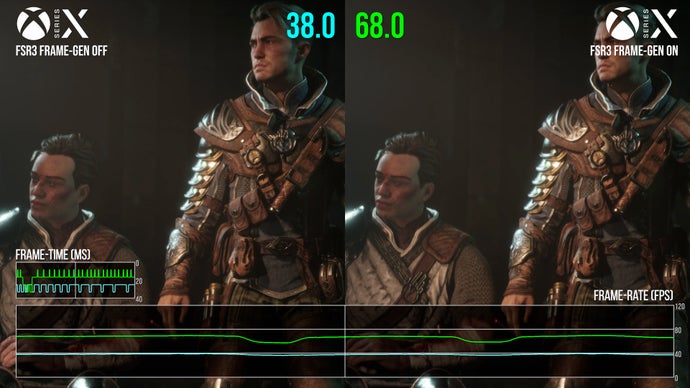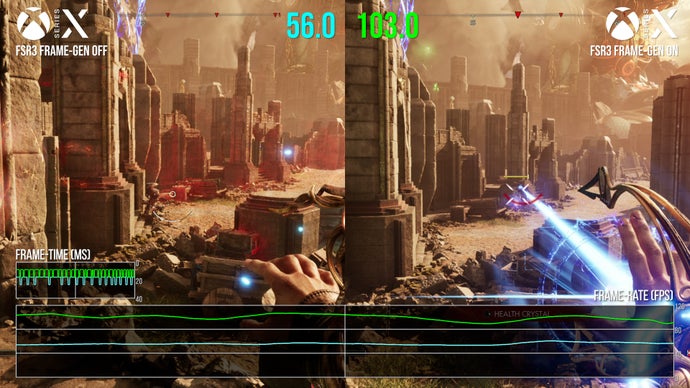Another week, another episode of DF Direct Weekly (hence the name) and this episode was actually split into two recording sessions. Normal filming occured on Friday morning, but at around 3pm, Ascendant Studios in association with Enduring Games, finally released its AMD FSR 3 frame generation upgrade for Immortals of Aveum. Initial testing from myself and John Linneman confirmed that it’s in, it’s working and it’s well worth talking about, so I put together some data and assets and we added a second part to the Direct. And here it is!
As a proof of concept for console frame generation, Immortals of Aveum is compelling, but let’s first deal with the basic details. Similar to Nvidia DLSS 3 frame-gen, AMD’s take works on buffering up an extra frame, on top of the one last rendered, then inserts an interpolated frame between them. In a best case scenario – basically when you’re CPU-limited with GPU cycles to spare – you’ll double the frame-rate from the host system, so a 60fps game becomes a 120fps game. However, when you’re GPU-limited – as is almost certainly the case with Aveum – gains will be lower.
The plus points are obvious though. In the case of Immortals of Aveum, which tends to run at between 40fps to 60fps, the experience moves beyond the 60fps limit and into HFR (high frame-rate) territory, making the game more compelling for those with 120Hz displays. However, there are minus points. Interpolated frames – particularly those sandwiched between two very different frames – will lack the fidelity of standard frames. Also, the process of buffering up an extra frame adds latency… and that will be the time taken to generate the extra frame along with the time taken to calculate the interpolated frame.
- 0:00:00 Introduction
- 0:01:15 News 01: Immortals of Aveum FSR3 frame-gen tested!
- 0:18:16 News 02: Hellblade 2 review reaction
- 0:45:34 News 03: IGN buys Gamer Network… but what about DF?
- 0:57:44 News 04: TopSpin 2K25 impressions
- 1:08:14 News 05: Snapdragon X Elite processors launch
- 1:21:37 News 06: New Paper Mario: The Thousand Year Door details
- 1:30:23 News 07: Ark: Survival Ascended features console menu on consoles
- 1:41:12 Supporter Q1: Should ‘artistic’ effects always be optional in games?
- 1:47:21 Supporter Q2: Should a frame-rate cap option be added to Ghost of Tsushima?
- 1:52:55 Supporter Q3: Future compatibility enhancements are very helpful – so should they be a standard feature in console games?
- 2:01:32 Supporter Q4: Is VRR becoming a crutch for console games?
- 2:09:00 Supporter Q5: Are full UE5 titles finally becoming common?
- 2:12:35 Supporter Q6: Which game should get an RTX Remix treatment?
- 2:17:15 Supporter Q7: By 2030, will 8K gaming be ‘a thing’?
So, the big question is simple, then: how does Immortals of Aveum stack up? We’re working on a full breakdown covering all the current-gen consoles (Series S has it!) but our first look was at Xbox Series X, which received the patch ahead of the PlayStation 5 version. As I expected back in the day, Ascendant isn’t looking to sustain 60fps with frame-gen but rather to produce a good HFR experience for HDMI 2.1 displays, especially with VRR (variable refresh rate).
However, there are some interesting options. First of all, a new toggle has been added that allows users to enable or disable v-sync. This wasn’t an option before – it was locked on. There’s also the option to enable or disable AMD FSR 3 frame generation. This is good for users because while we don’t like screen-tearing that much, tearing at high frame-rates in a 120Hz container does eliminate v-sync judder and can look perceptually smoother. It’s also good for Digital Foundry because it means we can take a look at frame-pacing with our capture cards – an area where FSR 3 frame generation struggled immensely when we first looked at it on PC, but did improve.
And yes, VRR is natively supported out of the box. On the Series X, just enable VRR on the menu, ensure 120Hz is enabled and you’re good to go. FSR 3 frame generation works well in producing interpolated frames and produces a noticeably smoother image. It’s easy to tell the difference toggling it on and off. It works. In VRR, the experience is fluid and that’s important because frame-rates on Series X generally sit around 70fps to 90fps. That’s fine for VRR, but will present fluidity issues without.
Another thing I found quite intriguing is that even with frame generation off but running at 120Hz, the game pumps out as many frames as possible, meaning that it’s possible to run at higher than 60fps. It doesn’thappen so often with the Series X version of the game, but it does with the Series S game, which – bizarrely – outperforms both X and PS5 by quite a margin, albeit with some remarkable visual downgrades and a very, very low internal resolution, pre-FSR upscaling.
I did note that the Xbox frame-gen implementation is not perfect. There appear to be intermediate freezing issues when there’s a camera cut during cinematics, but while a bit annoying, it does not intrude on gameplay (a quick look at PS5 doesn’t see this issue manifest). That said, just generally, Immortals of Aveum has noticeable Unreal Engine traversal stutter. Frame-gen cannot solve this and some might argue that dropping down from an even higher frame-rate makes the stutter even more noticeable.
There are HUD issues, too. 2D elements on the screen are rendered at the original frame-rate and are not interpolated. This is a perennial frame-gen issue (DLSS 3 can be affected too) but the issue with Aveum is that these elements are semi-transparent, with 3D elements visible beneath also subject to running at half-rate.


However, the proof of concept is solid. Immortals of Aveum demonstrates that FSR 3 frame generation has value. In challenging like-for-like content, I noted that Xbox Series X frame-rate rose from a 46.68fps average to 80.43fps – a 72.3 percent boost. More generally, frame generation turns a game running inconsistently at between 40fps to 60fps into an HFR experience, and with VRR active, it is compelling. While the interpolated frames are not perfect – sometimes dramatically so – they ‘strobe’ between two standard rendered frames. If the frame-rate’s high enough, it’s hard to detect those visual discrepancies.
Now, to answer the most obvious question. Will we see 30fps games ‘frame-genned’ into 60fps games? I don’t think that’s the best application of the technology, but it might work on much slower-paced titles. Immortals of Aveum represents how it will work best – taking a game already targeting 60fps and amplifying the frame-rate into HFR territory. As the game was a PlayStation Plus monthly giveaway and is out now on Game Pass, I’d recommend giving it a go. I’ll be back later in the week with a detailed breakdown on all supported systems, latency analysis and more.
